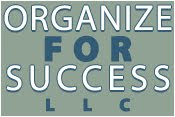 |
In real estate, there's an old adage of "location, location, location", highlighting the importance of where you choose to buy or rent. Well, organizing your office places the same importance on "location, location, location". Here are a few things to keep in mind when organizing your space:
- Make it easier to find what you need when you need it by limiting what is kept in your space... Purge what's unnecessary, and remember that "I might..." does not count as a reason to retain something.
- Keep the mantra "like with like" in mind to group like items together, making it easier to find what you need when you need it.
- When assigning homes to what you keep, store items closest to where you'll be using them, creating "stations" for each function of your job.
- Determine if your personality is more "out of sight is out of mind" or "in view creates visual clutter" so you use appropriate storage tools.
- Every item you retain should be assigned a "home" so it's easy to locate when needed and easy to put away when finished working with it.
- Once homes are assigned, be sure to clearly label what goes where... Label each file or container with terms that enable you to find what you need. There's no "right" or "wrong" verbiage to use when labeling each home.
- When creating your storage solutions, remember that "horizontal is hidden and vertical is visible" so you can easily see labels and know what you have.
- Separate "active" items from those you consider "archive", keeping actives closer for easier access while storing archives further away.
- Use color to group related items... Things you like less placed in files or containers that are of colors you prefer make those items less of a negative and drive actions.
- Move shared files / tools into a common space for team members to easily access in a timely manner whenever they are needed.
- Don't forget about walls and backs of doors... Often, these areas are wasted space, but they can provide a plethora of storage options.
- Remember "a place for everything and everything in its place" to stay organized for the long haul, particularly as new items arrive.
Are any of these tactics you are currently utilizing? Could any of them be implemented for your greater productivity?

